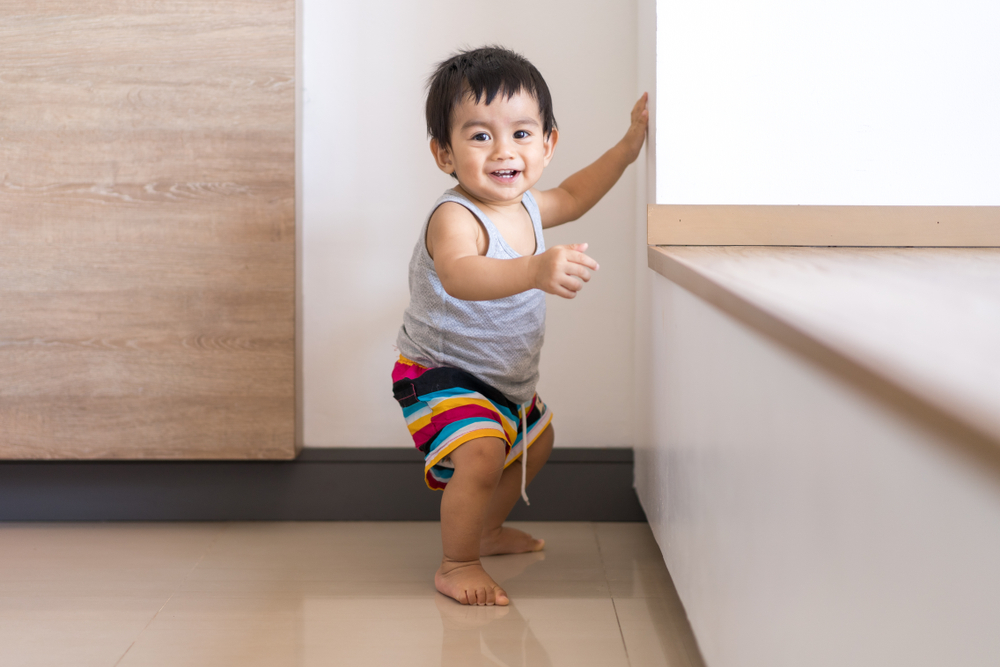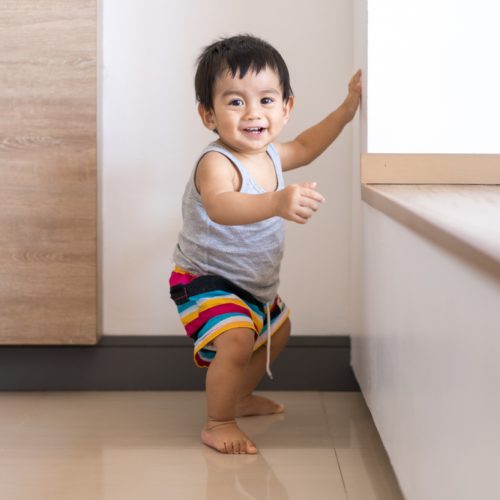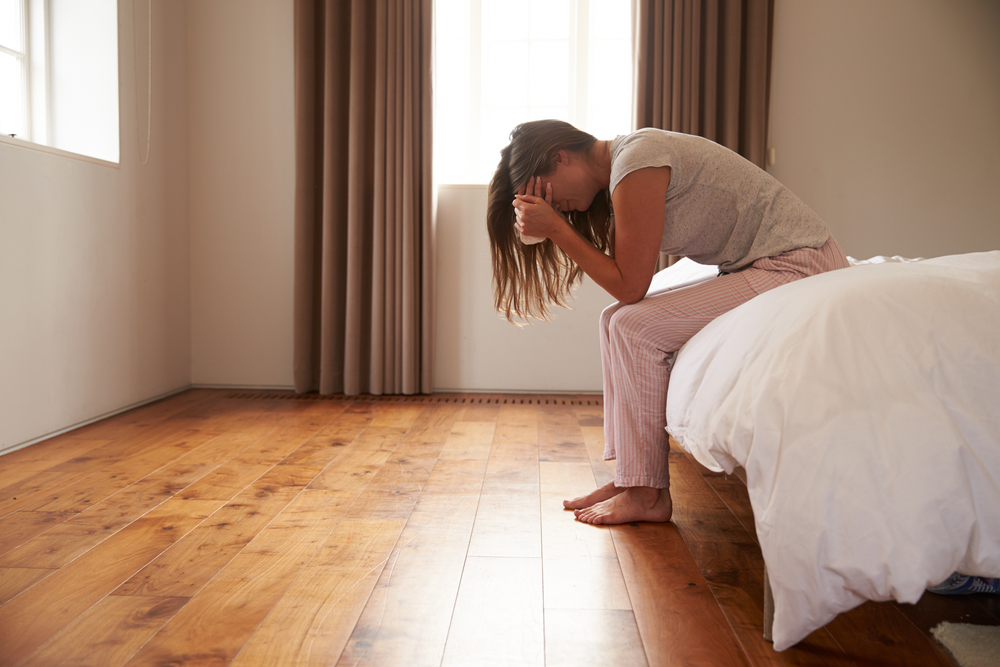The main takeaways for this guide take two minutes to read. It contains information from ten sources, including the American Academy of Pediatrics and Children’s Hospital of Los Angeles. See the full list below.
The baby walkers many of us rolled around in a few decades ago were officially blacklisted by the American Academy of Pediatrics in 2018, largely due to the injuries kids got from rolling where they weren’t supposed to go (e.g. the stairs). But what other infant/toddler play gear is considered safe (and doesn’t make learning to walk harder) can get confusing.
Here are the main takeaways we found on what play gear is safe for infants and toddlers according to the experts, gathered from 10 sources including the American Academy of Pediatrics and the Children’s Hospital of Los Angeles.
- Rolling baby walkers (the ones that have a seat for baby in the middle) are the only device the American Academy of Pediatrics (AAP) has called for a full ban on.
- The biggest concern with other gear (i.e. jumpers, activity centers, exersaucers) is that they stress babies’ bodies out by putting them into positions they aren’t ready for, and/or don’t position their bodies in a natural way, which can impede development.
- Limiting the amount of time kids are in a jumper, exersaucer, or activity center to 15 minutes about once or twice a day was the most common recommendation. And experts cautioned not to use these items until your baby can sit independently without balancing on their arms.
- None of the experts thought this gear would help your child learn to walk (push walkers were the slight exception.) Tummy time remains the number one recommendation for helping your infant develop motor skills.
Why the AAP Wants Walkers to Be Banned
In 2018, the American Academy of Pediatrics called for all infant walkers to be banned because there is “a considerable risk of major and minor injury and even death from the use of infant walkers,” while there is “no clear benefit from their use.”
The AAP reported that thousands of children every year had to be treated at the hospital due to injuries from walkers. The vast majority came from rolling down the stairs, but others injuries noted by the AAP include infants who get burned because they can reach higher objects (like a pot on the stove) in a walker or drowned when their walker tipped into a pool or bathtub.
Beyond all of these safety risks, the AAP says they don’t help children learn how to walk, and in contrast, can actually delay when a child starts to walk because the movements they use to move a walker around doesn’t translate to the movements needed to walk independently, and the children can’t see their feet and legs.
Want a quick way of seeing developmental milestones for ages 1 through 3?
Drop your email and we’ll send you a FREE, mobile-friendly graphic that breaks down the developmental milestones for ages 1 through 3, including walking, jumping, first words, and speaking in sentences. Favorite it so you can access whenever!
The Deal With Push Walkers
Push walkers–the kind that children push independently and are not seated in–are not included in this effort. Kendra Gagnon, a pediatric physical therapist, explains that these allow children to see their legs and feet and “practice standing and stepping in a much more natural way.” But Gangon adds that purchasing a commercial push walker often isn’t necessary, as objects often found around the house, like a laundry basket, doll stroller or just a large box, can serve the same purpose.

What Jumpers Are (And Are Not) Okay And For How Long
The overall message from experts is that jumping devices are okay as long as they are not used for more than a short period of time (15 minutes was the most common recommendation) and they are freestanding items and NOT attached to doorways.
Why a Time Limit?
Anne Zachry, professor of occupational therapy at the University of Tennessee Health Science Center, told USA Today that jumpers basically stress baby bodies out.
“All versions encourage standing on the tiptoes, which is not good for baby’s feet, and excess jumping puts unnecessary stress on an infant’s legs, hips and spines,” Zachry said.
Rachel Blackburn, a rehab nurse at the Children’s Hospital of Los Angeles, worked with Kevin Craig, a physician in Pediatric Rehabilitative Medicine at the same hospital to help parents identify which gear is safe.
Blackburn writes that while her kids loved their jumper, she limits the time to 10 to 15 minutes per day because the seat “puts their hips in a bad position developmentally. That position stresses the hip joint, and can actually cause harm like hip dysplasia, which is the malformation of the hip socket.”
Why Not Door Frames?
It has the same issues with hip development as freestanding jumpers, but there are more chances for injury from hitting the doorframe itself.
Zachry also cautioned against door frame jumpers, because they can lead to “dangers including head trauma, strangulation and whiplash.”
The staff at Children’s Hospital of LA also cautioned that doorframe jumpers mean children can knock their head into the doorframe since they can move side to side. Craig explained that because a baby’s head is proportionally larger than their body, “swinging too much or with too much force can cause injury to their neck.”
Activity Centers / Exersaucers
The AAP says these stationary items are a safer alternative to baby walkers that have children seated inside of them. But like jumpers, the way babies are positioned in the gear itself have some experts warning that they too can lead to physical developmental issues.
Christie Kiley, a pediatric occupational therapist, explains that the way babies are often seated in the activity center/exersaucer encourages them “to stand by locking out their knees in order to compensate for weakness because they’re placed in a standing position before they are ready for it.” She urges parents to wait until their babies can sit independently without using arms for balance (typically 6-7 months old) before putting them in the exersaucer. And like jumpers, she and other experts recommend a time limit of no more than 15-20 minutes per day.
Sources
- 7 Best Baby [Push] Walkers for 2021 | Healthline Parenthood
- Are Walkers Bad For Babies? Experts Say There Are Better Options (romper.com)
- Baby Walkers: A Dangerous Choice – HealthyChildren.org
- Cut Back on the Baby Gear and Boost Your Baby’s Development – (mamaot.com)
- Exersaucers: The good, the bad, the better – (mamaot.com)
- For babies’ development, go for activities, not gadgets (usatoday.com)
- Out of the Container, and Onto the Floor | American Academy of Pediatrics (aappublications.org)
- Parents: Don’t use a baby walker – Harvard Health
- Safety Tips for Buying Baby Gear | Children’s Hospital Los Angeles (chla.org)
- Tummy Time and Infant Health Outcomes: A Systematic Review | American Academy of Pediatrics (aappublications.org)
- On walking (and why you won’t see a physical therapist’s kid using a baby walker) | Kendra Ped PT
- Injuries Associated With Infant Walkers | American Academy of Pediatrics (aappublications.org)


